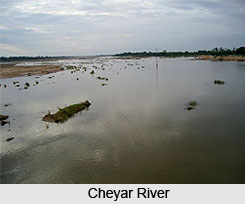 River Cheyar flows through Chengam Taluka of Thiruvannamalai district and is an important seasonal river of the region. It is a perennial river of Palar River, a river which originates in Kolar from Jawadhu Hills, Karnataka and flows through Vellore, Thiruvannamalai district and Kanchipuram district of Tamil Nadu before emptying into the Bay of Bengal. The main tributaries of the Palar are the Ponnaiyar and the Cheyar rivers.
River Cheyar flows through Chengam Taluka of Thiruvannamalai district and is an important seasonal river of the region. It is a perennial river of Palar River, a river which originates in Kolar from Jawadhu Hills, Karnataka and flows through Vellore, Thiruvannamalai district and Kanchipuram district of Tamil Nadu before emptying into the Bay of Bengal. The main tributaries of the Palar are the Ponnaiyar and the Cheyar rivers.
It receives rain during the Northeast and Southwest monsoon periods. Cheyar River passes through several villages of Chengam Taluka, and is the major source of irrigation for several villages, including the towns of Cheyar, Vandavasi along its bank. The Taluka has different types of soil, such as black, red loam and sandy loam. Major crops raised in the Taluka are paddy and groundnut. Magaral lies on the northern banks of Cheyar River. The Vedapureeswarar Temple is located on the banks of the Cheyar River.
Temples near Cheyar River
An ancient temple, the Vedapureeswarar Temple anciently known as Vedhanadeshwarar temple situated on the bank of the river at Cheyar town. There is a legend that Thirugnana Sambandar, one of the four great saivite saints, visited the temple and changed a male palm tree to a female palm tree which can yield palm fruit by singing verses in Tamil. The ancient name for Cheyaru river is "Sei Aaru" (Child river) meaning that the river is created for a child to play. History says that Goddess Parvati made a line on the earth"s surface with her Trisul to make a river for her son, Lord Muruga to play. The river is still believed to be a Holy River even today on Cheyar and its surrounding villages.
This article is a stub. You can enrich by adding more information to it. Send your Write Up to content@indianetzone.com



















